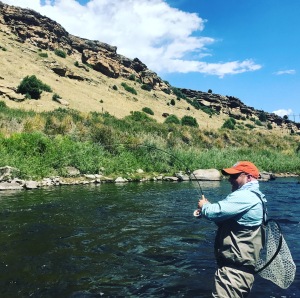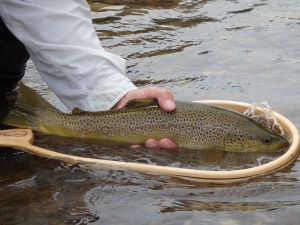Hidy Ho Good Neighbors!
“I probably would’ve set on that”. “I didn’t even see it move”, he replied. I said automatically, “Yea, we need to keep working on the take recognition”. All too often, I watch fish after fish eat our offerings and nothing is done on the business side of the fly rod. Doesn’t matter, it could be an eat on the swing, lift, drift or surface, and nothing happens.
I’m beyond getting frustrated with clients when they don’t recognize a fish eating their offerings; I try instead, to use it as a teaching tool. Breaking down the missed opportunity right after the fact, seems to more completely reinforce the need and timing of something that should have been set upon, than beating them over the head with it. And, like magic, once they relax and hook a few, they begin to recognize more eats and set more quickly.
I think most folks, even my experienced clients, that miss fish are usually preoccupied with working on another skill, and/or are overwhelmed with tougher drifts. The tougher the drift, the more mending, and the more difficult it becomes to babysit the drift. Many times clients miss takes because they are watching their hands and the fly line to ensure a good drift, and lose focus on the indicator, indicator fly (dry-dropper), or the dry fly on the surface. Sometimes, when working on advanced skills, such as, pause and go mending, folks again lose focus on the take, and miss fish. It’s easy to do.
So, how do you fix this? What do you do if you are continually missing fish? Simplify. In this case, simplification takes place in two ways: doing less while perfecting more. Perfect the ability to mend without taking your eyes off of the indicator, sighter leader, dry fly, or indicator fly. As you become more proficient at having both hands work as one, you will begin to do less, work less, and simplify the drift. So, the first simplification is teaching the hands to work together, next skill is to stop out-casting your coverage.
Out-casting your coverage begins when you have too much line out for your skill level. I believe in healthy management loops below the reel, and large slack mends if your skill level calls for it, but once you feel as if you are continually mending in your drift and can’t keep up, be honest and realize you’ve hit your limit. No shame in that, just keep working to increase your coverage. Again, simplify.
This sounds basic, but many folks don’t really know how to set once they do recognize an eat. All sets are not created equal. Nymph drift sets are a low sweeping motion downstream over the water. You must set the distance required to actually straighten out the line to pierce the lip. Many folks set quickly enough, but “short-set” and never straighten the line. The dry fly and dry-dropper set are usually downstream over the downstream shoulder. Much less force is applied than the nymph set because there’s not as much drag on the rig, and too much force can result in a snap-off. Be careful to set “against the fish” when setting on a dry fly, striving to set from the fish’s head to its tail. Streamer sets are completed by using your stripping hand to set the hook by pulling the management loop back toward your butt pants pocket as if you’re completing a large streamer strip. Again, these are simple sets, but require a bit of practice.
A few other tidbits: strive to learn to “vicinity set”. Try to set on any fish flash within the vicinity of your flies. For example: if you’re running a nymph rig 8 feet from indicator to your last fly, set on any fish flash within four feet of the indicator. More often than not, if you set on a fish flash within the vicinity of your drift, you’ll move a fish. If you are sight fishing, and can see the fish, learn to set on fish movement. If the fish are feeding side-to-side, set when they swing to one side and stop, before returning to their position. Same thing if fish are porpoising, set when they stop, before they go back down to their original position.
There’s much more to cover here, and I go into great detail in my next book, Hidden in Plain View. The book is now in pre-sales, I think you’ll like it. It was recently the number one new fishing book, so I’m pretty pleased with that. Amazon, Barnes and Noble are offering presale discounts for a short time.
Simplify, simplify, simplify, and Fear No Water!
Duane





Leave a comment